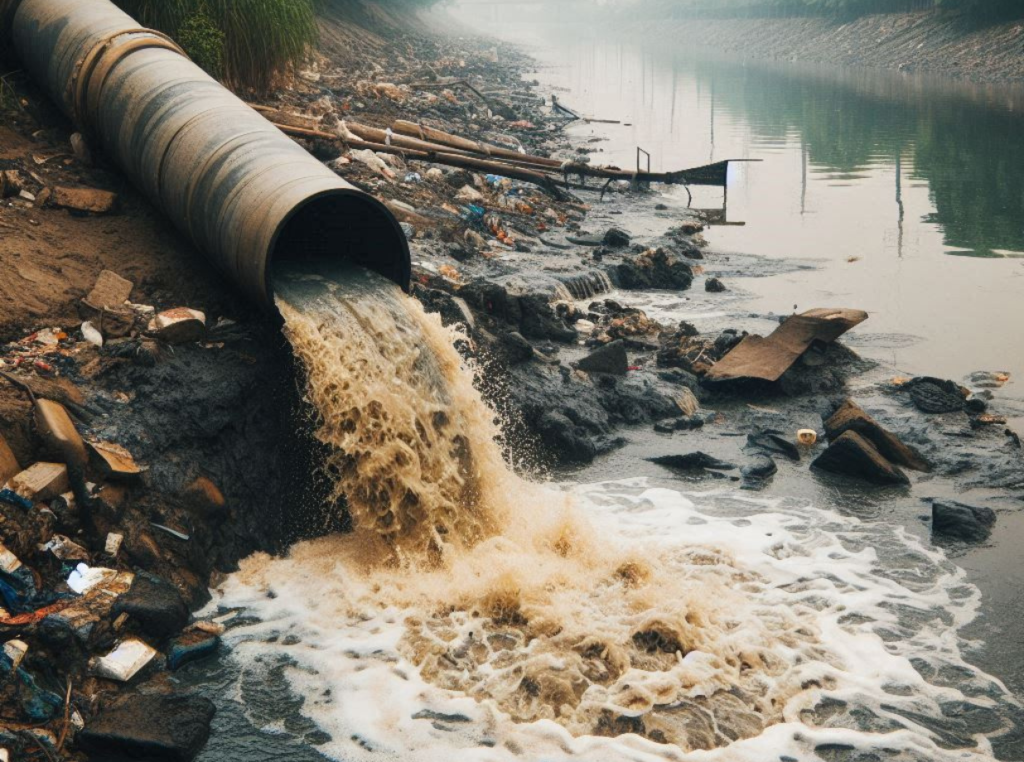The National Pollutant Discharge Elimination System (NPDES) is a crucial program for protecting the United States’ waterways. Established under the Clean Water Act, NPDES regulates point sources of pollution by issuing permits that specify the maximum allowable limits of pollutants that can be discharged into water bodies. These permits are issued to industries, municipalities, and facilities that release pollutants into waterways, with the goal of preserving water quality and protecting aquatic life.

The Environmental Protection Agency (EPA) administers the NPDES program, delegating authority to state environmental agencies in certain cases. The program has significantly contributed to reducing water pollution and improving the health of the nation’s waterways. The NPDES program is vital for safeguarding waterways because it ensures that pollutant discharges do not compromise water quality or harm aquatic life.
By establishing limits on pollutant discharges, the program prevents the contamination of rivers, lakes, and streams, which is essential for maintaining public health, supporting recreation, and preserving wildlife habitats. Additionally, the NPDES program helps prevent the spread of waterborne diseases and protects the health of communities that rely on clean water for their daily needs. Overall, the program plays a critical role in protecting the nation’s water resources for current and future generations.
Key Takeaways
- NPDES is a key player in protecting our waterways by regulating pollutants and preventing water pollution.
- Understanding the NPDES program is crucial for ensuring water quality protection and public health.
- NPDES plays a vital role in regulating pollutants in waterways and preventing contamination.
- Compliance and enforcement of NPDES regulations are essential for maintaining water quality and environmental protection.
- The future of NPDES presents both challenges and opportunities for furthering waterway protection and public health.
The Importance of NPDES in Water Quality Protection
The NPDES program is of utmost importance in protecting water quality. It ensures that discharges of pollutants into waterways are carefully monitored and regulated, which helps to prevent contamination and degradation of our nation’s water resources. By setting limits on the amount of pollutants that can be discharged, the program helps to maintain the integrity of our rivers, lakes, and streams.
This is essential for protecting aquatic life and preserving the natural beauty of our waterways. Additionally, the NPDES program helps to safeguard public health by preventing the spread of waterborne diseases and ensuring that communities have access to clean and safe drinking water. Furthermore, the NPDES program is crucial for maintaining the ecological balance of our waterways.
By regulating point sources of pollution, the program helps to protect sensitive ecosystems and preserve biodiversity. This is essential for supporting healthy fish and wildlife populations, as well as providing recreational opportunities for people to enjoy nature. The program also plays a key role in supporting economic activities such as fishing, boating, and tourism, which rely on clean and healthy waterways.
How NPDES Regulates Pollutants in Waterways
The NPDES program regulates pollutants in waterways by issuing permits to point sources of pollution that set limits on the amount of pollutants that can be discharged. These permits are tailored to specific facilities and their discharges, taking into account factors such as the type of pollutants being discharged, the receiving water body, and the potential impacts on water quality and aquatic life. The permits also require facilities to monitor their discharges and report their findings to regulatory authorities, which helps to ensure compliance with permit limits and identify any potential issues with pollution control measures.
In addition to setting permit limits, the NPDES program also requires facilities to implement best management practices (BMPs) to control their discharges and prevent pollution. These practices may include measures such as installing treatment systems, implementing pollution prevention measures, and conducting regular inspections and maintenance of equipment. By requiring facilities to implement BMPs, the program helps to minimize the impact of their discharges on water quality and aquatic life.

The Role of NPDES in Preventing Water Pollution
| NPDES Permittees | Number of Permits | Compliance Rate |
|---|---|---|
| Municipalities | 5,000 | 85% |
| Industrial Facilities | 20,000 | 90% |
| Agricultural Operations | 10,000 | 75% |
The NPDES program plays a critical role in preventing water pollution by regulating point sources of pollution and setting limits on the amount of pollutants that can be discharged into waterways. By requiring facilities to obtain permits and comply with permit limits, the program helps to ensure that discharges do not harm water quality or aquatic life. This is essential for preventing contamination of our rivers, lakes, and streams, as well as protecting public health and the environment.
The program also helps to prevent the spread of waterborne diseases by ensuring that communities have access to clean and safe drinking water. Furthermore, the NPDES program helps to prevent water pollution by requiring facilities to implement best management practices (BMPs) to control their discharges and prevent pollution. These practices help to minimize the impact of discharges on water quality and aquatic life, as well as support healthy ecosystems and biodiversity.
By requiring facilities to implement BMPs, the program helps to prevent pollution at its source and reduce the need for costly cleanup efforts downstream. Overall, the NPDES program plays a crucial role in preventing water pollution and protecting our nation’s water resources for current and future generations.
Compliance and Enforcement of NPDES Regulations
Compliance with NPDES regulations is essential for protecting water quality and ensuring that discharges do not harm aquatic life or public health. The NPDES program requires facilities to obtain permits and comply with permit limits, as well as implement best management practices (BMPs) to control their discharges and prevent pollution. To ensure compliance with these requirements, regulatory authorities conduct inspections of facilities, review monitoring data, and take enforcement actions against violators.
These actions may include issuing penalties, requiring corrective actions, or revoking permits for non-compliance. Enforcement of NPDES regulations is critical for maintaining the integrity of our nation’s water resources and holding polluters accountable for their actions. By taking enforcement actions against violators, regulatory authorities help to deter non-compliance with permit limits and BMPs, as well as protect public health and the environment.
This is essential for ensuring that discharges do not harm water quality or aquatic life, as well as preventing contamination of our rivers, lakes, and streams. Overall, compliance with NPDES regulations is essential for protecting water quality and ensuring the sustainability of our nation’s water resources.
The Impact of NPDES on Public Health and the Environment
The NPDES program has a significant impact on public health and the environment by preventing water pollution and ensuring that communities have access to clean and safe drinking water. By regulating point sources of pollution and setting limits on the amount of pollutants that can be discharged into waterways, the program helps to protect public health by preventing the spread of waterborne diseases. This is essential for ensuring that communities can rely on clean and safe drinking water for their daily needs, as well as supporting healthy ecosystems and biodiversity.
Furthermore, the NPDES program has a positive impact on the environment by protecting water quality and aquatic life. By regulating pollutants in waterways and requiring facilities to implement best management practices (BMPs) to control their discharges, the program helps to minimize the impact of pollution on sensitive ecosystems and preserve biodiversity. This is essential for supporting healthy fish and wildlife populations, as well as providing recreational opportunities for people to enjoy nature.
Future Challenges and Opportunities for NPDES in Waterway Protection
Looking ahead, the NPDES program faces several challenges and opportunities in protecting our nation’s waterways. One challenge is addressing emerging contaminants such as pharmaceuticals, personal care products, and microplastics that may not be adequately regulated under current permit limits. These contaminants pose a threat to water quality and aquatic life, as well as public health, and require additional research and regulatory action to address effectively.
Another challenge is addressing non-point sources of pollution such as urban runoff, agricultural runoff, and atmospheric deposition that may contribute to water pollution but are not currently regulated under the NPDES program. Despite these challenges, there are also opportunities for the NPDES program to enhance its effectiveness in protecting water quality. One opportunity is leveraging new technologies such as advanced monitoring systems, remote sensing technologies, and data analytics to improve compliance monitoring and enforcement efforts.
These technologies can help regulatory authorities identify potential issues with pollution control measures more effectively and take timely enforcement actions against violators. Another opportunity is strengthening partnerships with stakeholders such as industry, municipalities, environmental organizations, and communities to promote collaborative approaches to addressing water quality challenges. By working together, these stakeholders can develop innovative solutions to protect our nation’s water resources effectively.

Conclusion
In conclusion, the NPDES program plays a crucial role in protecting our nation’s waterways by regulating point sources of pollution and setting limits on the amount of pollutants that can be discharged into water bodies. The program is essential for preventing water pollution, safeguarding public health, preserving biodiversity, supporting economic activities, and ensuring the sustainability of our nation’s water resources. While the program faces challenges in addressing emerging contaminants and non-point sources of pollution, there are also opportunities for leveraging new technologies and strengthening partnerships with stakeholders to enhance its effectiveness in protecting water quality.
Additional Resources
Here’s a resource list with five websites providing information on the National Pollutant Discharge Elimination System (NPDES) and water quality protection:
U.S. Environmental Protection Agency (EPA) – NPDES
- EPA NPDES Program Overview
- Comprehensive source for NPDES regulations, permits, and compliance information.
National Pollutant Discharge Elimination System (NPDES) – Water Environment Federation (WEF)
- WEF NPDES Resource
- Provides educational materials and updates on NPDES-related water quality issues.
Clean Water Act – Legal Information Institute (Cornell Law School)
- Clean Water Act Overview
- Detailed legal information on the Clean Water Act, under which NPDES operates.
Waterkeeper Alliance – Water Pollution Information
- Waterkeeper Alliance NPDES Information
- Focuses on protecting water resources and advocating for clean water regulations, including NPDES enforcement.
National Association of Clean Water Agencies (NACWA)
- NACWA NPDES Information
- Provides resources on NPDES permits, regulatory updates, and advocacy efforts related to clean water.